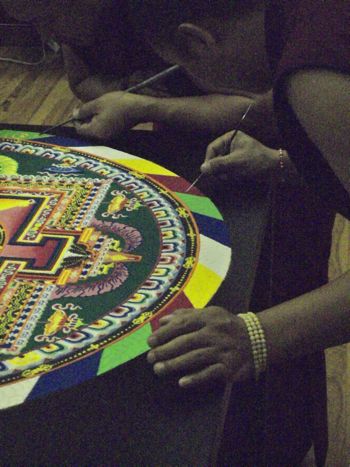Another picture of the monks working; the monk closest to the camera is incising a design into a background using a stylus (the point of a compass, actually); the monk at rear is adding a line of sand to the incised design:

At the end of the day today, the mandala was nearly complete:
It is hard to see in this photo, but the mandala is not a two-dimensional work; the sand is built up in low relief that is difficult to capture in a photograph.


2 recovered comments
Jeff says:
January 17, 2011 at 5:37 am
They may have told y’all this on site, but in case they didn’t, the sand mandala is a (more or less) two-dimensional representation of a three-dimensional object: the painting depicts a grand heavenly palace in which live various enlightened deities, buddhas, and bodhisattvas. While they out of necessity draw it in (mostly) two dimensions, the visualizations they perform during the construction and the prayers and chants that describe the palace and invite the deities to come and inhabit it on site all represent it as three dimensional, and thus from an insider’s point of view it is viewed as being actually three-dimensional (but, not perceptible as such except by the awakened consciousness). Just thought you’d find that interesting.
Dan says:
January 18, 2011 at 12:00 am
Jeff @ 1 — Thanks, I did not know this; great concise explanation.
The monks did not tell us any of this through their translator. I decided to write about as straight reportage, telling exactly what I saw and experienced. Not having an awakened consciousness, I admit I did not perceive any deities myself. All I experienced was a beautiful work of four-dimensional religious art being made in a meditative manner by excellent good craftsmen (I call it four-dimensional using terminology of Western art for works that intentionally use time as one dimension).